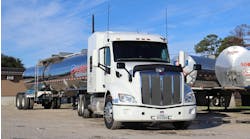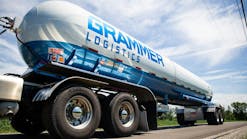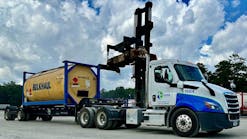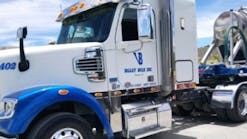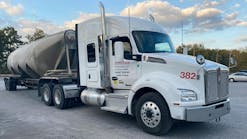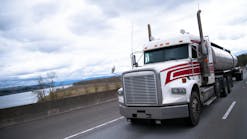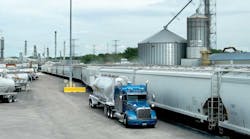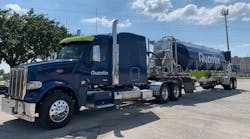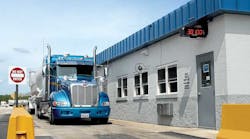A&R Logistics leaves nothing to chance in its transloading operations
WHEN it comes to transloading, A&R Logistics Inc goes to great lengths to make sure employees are “Doing it Right.” Extra emphasis on the transload process helps ensure that customers get the very best service.
Those customers include some of the largest plastics producers in the United States. Concentrated along the Gulf Coast, they ship $3 billion to $4 billion worth of plastics annually with A&R Logistics. A large percentage of the North American shipments are transloaded at some point during the transportation process.
Louisville, Kentucky-based A&R Logistics plays a big role in the plastic pellets distribution process in North America, handling 40% of the total plastics volume transported on highway. In serving its customers, the carrier performed 145,000 transloads in 2014 and should end 2015 in the same range.
“We have 19 transload locations across the United States that we own, lease, or manage,” says Lisa Grow, A&R Logistics director of marketing. “A majority of the transload sites are at our own terminals and give us greater flexibility for operating hours and pre-loading. In total, the transload locations under A&R Logistics control offer more than 1,800 car spots. Our largest company-owned transload location is at our Morris, Illinois, terminal where we have 425 car spots.
“We also serve customers out of a number of third-party transload facilities, and we manage some customer rail yards. One of the largest customer rail yards is near our Highlands, Texas, terminal. A&R Logistics transloads roughly 200 million pounds of plastics annually out of that rail yard.
“Warehouses for plastics storage are part of our product mix, and most of them have rail access. We currently have 11 warehouses in our system, and we are aggressively upgrading those operations. For instance, new warehouse facilities have replaced older locations in Atlanta, Georgia; Jeffersonville, Indiana; and Fort Worth, Texas. We have also invested over $1 million in Highjump, a state-of-the-art, highly scalable warehouse management system.”
Production rising
Grow says that while the past year was relatively flat for chemicals—including plastics—A&R Logistics remains optimistic about the future. “Shipments of polyethylene—a big product for us—were flat in the early part of 2015, but picked up very nicely in the second half of the year,” Grow says. “We also saw increased demand for polypropylene, with much of that demand coming from the automotive sector.”
In the longer term, plastics production—especially along the Gulf Coast—is expected to grow by approximately 62% over the next 10 years, increasing from 14.3 million tons in 2014 to roughly 23.1 million tons. Billions of dollars are being invested in plant expansions by the major producers in the Houston, Texas area.
Much of the increased plastics production will be exported, according to Grow. However, there are growing concerns about the current packager and port capacities throughout the Gulf Coast. Currently, many Gulf Coast ports, where resins are historically packaged and exported, are experiencing—or are expecting to experience—shortages in packaging, warehousing, trucking, and equipment as exports increase.
By working with its customer base, A&R Logistics is building additional export capacity to provide an alternative for plastics producers in the Houston area.
“A&R logistics solutions will be more efficient and cost effective for plastics shipments for several reasons,” Grow says. “Most importantly, A&R logistics is focusing on eliminating the issues of equipment, trucking, and warehouse coordination, making export easier for our customers.”
Driver supply
Even with the broader rail partnership, A&R Logistics remains focused on the trucking side of transloading. The carrier currently runs 725 company tractors, more than 100 owner-operator tractors, and over 1,000 pneumatic self-loading vacuum trailers.
One of the biggest challenges in recent years has been finding enough truck drivers, but that situation is changing for the better. The supply of experienced truck drivers is improving.
“Right now we have enough company drivers to meet demand, and our company tractors are almost fully seated,” Grow says. “It has become easier to find experienced drivers as our needs change. We believe quite a few truck drivers are coming back from the oilfield, which is making a big difference.”
Regardless of experience, newly signed drivers are put through a 90-day initial training program that starts with classroom instruction at one of three A&R Logistics training sites at the terminals in Atlanta, Highlands, and Morris. At a minimum, a newly signed driver spends one week at one of the three training centers, two weeks at his home terminal, and the remainder of the time in on-the-job training under the supervision of a driver trainer.
That first week of classroom instruction is a 40-hour program designed to provide a uniform message on job requirements and the carrier’s expectations for every employee, according to Bill Bone, A&R Logistics vice-president of safety and driver development. It combines classroom activity and hand-on training with the equipment that will be used in the field.
“This is the first introduction to transloading for many of these people,” Bone says. “We focus on 10 different hard skills during this initial phase of the training, including eLogs, J&L dry bulkers, phase unloading of trailers, confined-space requirements, and bills of lading. This step ends with a comprehensive exam that looks at their overall job knowledge, with a focus on safety, dependability, and problem solving. Our drivers are trained to do it right from the beginning to finish of every load.
“At the outset of the training, we provide each new driver with a hardhat, goggles, gloves, reflective safety vest, and a flashlight. We provide respirator training, and we make sure they know respirators are available when needed.”
Hands on
The training is very much a practical, hands-on approach to the specialized requirements of transloading operations. Key elements in the initial training process at each training center are a dry bulk trailer connected to a transload simulator.
Developed in-house by Steve Brantley, A&R Logistics vice-president of Gulf Coast sales and operations, and his management team at the Highlands terminal, the simulator consists of a 23,000-lb-capacity silo with railcar and silo fittings. The silo can handle 8” to 10” of vacuum, and a load of plastic pellets can be transferred between the trailer and the silo in about 20 minutes.
“We put the first of these simulator silos together about a year-and-a-half ago because we wanted more consistency in our transload training,” Brantley says. “Transloading is a critical part of our operation, and we strive provide our customers with the highest service without compromising safety.
“When new drivers come in, we have to give them as much training as we can in a relatively short amount of time. These simulators are making a real difference with our drivers. We’re seeing fewer contaminations and more accurate trailer loading. We’ve seen a significant drop in service issues. We’ve always had good transload procedures, but the simulator just does a better job of bringing the whole process together for our drivers.”
Each new driver spends about seven hours on the simulator during the initial training. That is just the beginning though. Even the most experienced veteran drivers go through a recertification process that includes simulator time every 12 to 18 months. Drivers also can be sent for retraining as needed to address specific performance issues.
Training steps
During the initial training, new drivers learn about the hopper car hardware, the silo hardware, and the trailer equipment. A dedicated instructor at each training center takes drivers through the transload process step by step with the trailer and simulator.
The process starts with the driver removing the outlet cap on the railcar system and inspecting for any contaminants of water before connecting the transload hose. Straps and are used to ensure that the product hose won’t come loose during process of transloading plastic pellets from the railcar/silo. Hose stands keep the product hose off the ground.
Once the product hose is connected to the railcar outlet, the driver connects the other end of the hose to the trailer load line. Velcro straps around the hose coupling ears minimize the chance of them coming loose during transloading.
Trainees also go through the complete process of off-loading plastic pellets into the silo. Again Velcro straps are used to help ensure that hoses can’t become disconnected during the transfer process and the hose is supported on a hose stand.
Self loaders
The trailers used in the training process are typical of the Heil and J&L pneumatic self-loaders used in the A&R Logistics fleet. Bulker capacity ranges from 1,600 to 1,625 cubic feet. Hardware includes butterfly valves from Sure Seal, Pelican International, and UltraFlo.
Tractors and trailers have Right Weigh on-board scales. The newest trailers in the fleet have a front fill line and a Salco diverter valve that enables better weight distribution of the cargo.
“Our customers are looking for ways to lower distribution costs, and payload optimization is the key,” Grow says. “Our target is a payload of 47,500 to 48,000 pounds.”
Brantley adds that the carrier began using the diverter, front fill line, and on-board scales in 2003. “This system boosts safety and productivity,” he says. “On the safety side, we’re able to keep drivers off the trailers. In terms of productivity, the diverter and front fill reduce the loading time and enable us to fine-tune axle loading. We have installed the system on all of the trailers based at the Highlands terminal, and we are gradually rolling it out to the rest of the fleet.” ♦
